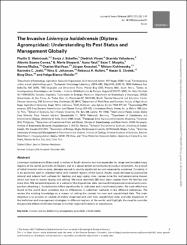The invasive liriomyza huidobrensis (Diptera: Agromyzidae): Understanding its pest status and management globally

Göster/
Tarih
2017Yazar
Weintraub, Phyllis G.Scheffer, Sonja J.
Visser, Diedrich
Valladares, Graciela
Correa, Alberto Soares
Shepard, B. Merle
Chen, Bing
Civelek, Hasan S.
Üst veri
Tüm öğe kaydını gösterÖzet
Liriomyza huidobrensis (Blanchard) is native to South America but has expanded its range and invaded many regions of the world, primarily on flowers and to a lesser extent on horticultural product shipments. As a result of initial invasion into an area, damage caused is usually significant but not necessarily sustained. Currently, it is an economic pest in selected native and invaded regions of the world. Adults cause damage by puncturing abaxial and adaxial leaf surfaces for feeding and egg laying sites. Larvae mine the leaf parenchyma tissues which can lead to leaves drying and wilting. We have recorded 365 host plant species from 49 families and more than 106 parasitoid species. In a subset of the Argentinian data, we found that parasitoid community composition attacking L. huidobrensis differs significantly in cultivated and uncultivated plants. No such effect was found at the world level, probably due to differences in collection methods in the different references. We review the existing knowledge as a means of setting the context for new and unpublished data. The main objective is to provide an update of widely dispersed and until now unpublished data, evaluate dispersion of the leafminer and management strategies in different regions of the world, and highlight the need to consider the possible effects of climate change on further regional invasions or expansions. © 2017 The Authors. Published by Oxford University Press on behalf of Entomological Society of America.

















